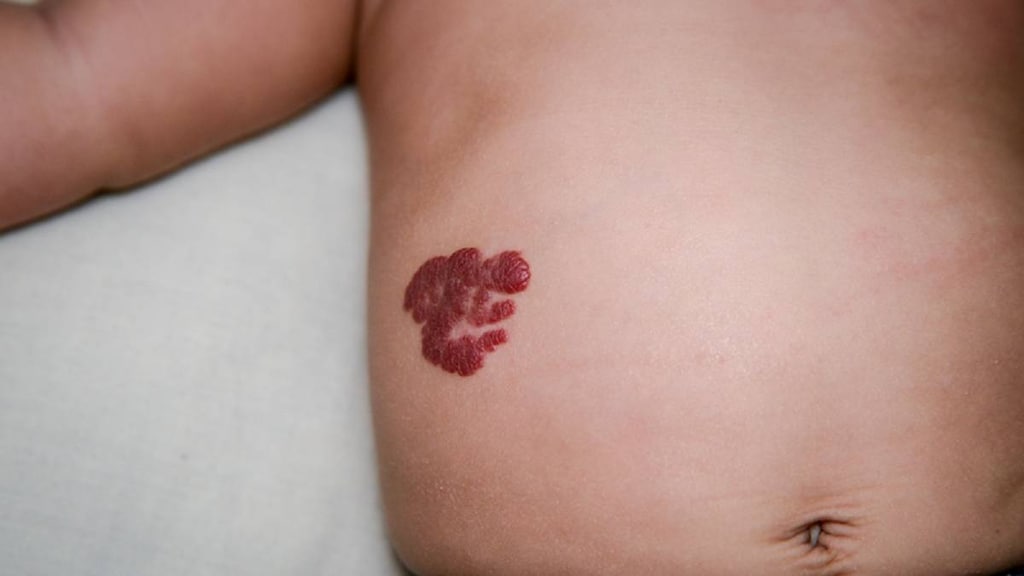
What are hemangiomas?
Hemangiomas are noncancerous growths (tumors) that are made up of blood vessels.
There are many different types of hemangiomas and they can occur on the skin, muscle, bone, or internal organs.
Hemangiomas are the most common type of noncancerous tumor in children.
What causes hemangiomas?
Hemangiomas are made up of extra blood vessels that clump together in a certain area. Experts aren’t sure what causes these blood vessels to clump.
Infantile hemangiomas are common, appearing in 4-10% of Caucasian infants either at birth or within the first few months of life. Premature infants and girl babies are more likely than males or Asian infants to develop one. They are rare in African-American babies.
Some hemangiomas develop or worsen during pregnancy, with injury, or with certain medications.
What are the symptoms of hemangiomas?
Some hemangiomas are present at birth whereas others develop within the first few months of life or in adults (such as during pregnancy).
Symptoms depend on the type of hemangioma, for example:
- Infantile Hemangiomas
- Cavernous hemangiomas
- Compound hemangiomas
- Lobular capillary hemangiomas (pyogenic hemangioma)
Infantile Hemangiomas
These typically appear on or just under the skin within one to three weeks after birth. They may start as a faint flat red or brown mark anywhere on the body, most commonly on the face, scalp, chest or back.
Capillary hemangiomas are the most common type and are often referred to as a “strawberry mark”. They grow rapidly over a baby’s first two to four months, brightening in color and taking on a spongy, rubbery-looking appearance. This is called the proliferative phase. The next phase is called the involution phase and during this time the hemangioma starts to fade, shrink, and slowly disappear. Most are gone by the time a child is aged three to five, although some may leave residual areas of extra skin or small blood vessels called telangiectasias.
Some children have multiple hemangiomas (up to several hundred). Those with more than five are at increased risk for organ involvement; the liver is commonly affected. Some hemangiomas can also affect the airways or occlude vision.
Other types of hemangiomas
These may occur in infants or other ages and include:
- Cavernous or deep hemangiomas: These are similar to capillary hemangiomas but are more deeply situated. They may appear as a red-blue spongy swelling under the skin.
- Compound or combination hemangiomas: These have both superficial and deep parts and can be very large spreading over the face or located on the nasal tip, mouth, or jaw.
- Lobular capillary hemangiomas (pyogenic granuloma): These usually appear as raised bright red lesions that bleed easily and grow quickly. They often appear during pregnancy, after injury or after using certain medications, particularly chemotherapy treatments.
How are hemangiomas diagnosed?
If you or your baby have a hemangioma, talk to your doctor about it at your next visit.
In most cases, your doctor will just monitor the hemangioma during routine visits, but you should see your doctor if your hemangioma bleeds or looks infected, or it interferes with your child’s vision, breathing or hearing.
How are hemangiomas treated?
Most hemangiomas do not require any treatment because they rarely become cancerous; however, some people may seek treatment for cosmetic reasons. Some children’s hospitals specialize in the management of infantile hemangiomas and arguably offer the best advice about treatment.
Treatment does not involve surgery in most circumstances, although surgery may be considered for hemangiomas that are deep in the muscle or bone, or if growths on the skin cause problems with vision, breathing or eating.
Pharmacological treatments that may be considered for hemangiomas include oral or topical beta-blockers or corticosteroids. Laser surgery may also be an option.




